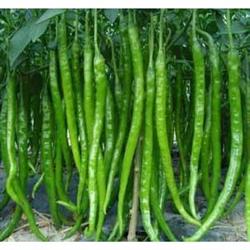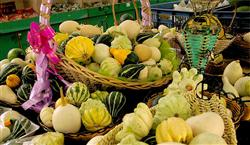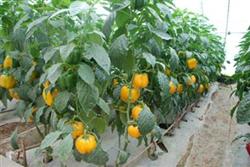Cultivation techniques of winter pumpkin

1. The three varieties introduced are Juhong No. 3 pumpkin (Jiangsu Zhengda seed Co., Ltd.), Honghui pumpkin and Hongying pumpkin (Beijing Edwin seed Co., Ltd.). The above three varieties all have certain cold tolerance and disease resistance, and have the characteristics of sweet powder, good commerciality, resistance to storage and transportation and so on. 2. Sowing and raising seedlings 1. Sowing time: the sowing time is generally chosen to sow from mid-September to early October. From sowing and raising seedlings to fruit harvest, the whole growth period is about 90-100 days. 2. Soaking seeds to accelerate germination: the seeds should be insolated for 2-3 hours before sowing to improve the germination rate. Then soak the seeds in 0.1% potassium permanganate solution for 30 minutes, remove them, clean them, wrap them in a 32 ℃ incubator with wet steps and accelerate germination. After 2-3 days, the seeds begin to show white. 3. Cultivate strong seedlings: 50g compound fertilizer and 10g carbendazim were mixed and leveled with 50g compound fertilizer and 10g carbendazim per square meter, and the radicles of germinating seeds were sown evenly on the seedling bed. After the seedlings are unearthed, pay attention to control the temperature and humidity of the seedling bed. When the temperature is low, it can be covered with straw or film. Seedlings in the growth of the first true leaf, and time seedlings, and disease-free weak seedlings. Foliar fertilizer is sprayed every 7-10 days. It can be planted when the seedlings grow to true leaves for 2-3 days. Third, the field cultivation management aims at less Rain Water in winter, and the field cultivation method can be cultivated on the ground, which can save the cost and improve the economic benefit. 1. Land preparation and planting: take up the border on the flat land and trim it to the specification of border width 1.2m, ditch 04.m and border height 80cm. According to the specification of 1.5m plant distance, 278 plants can be planted per mu on average. The seedlings should be transplanted with soil to protect the roots, and the roots should be drenched with water after transplanting. 2. Cultivation management during the growing period: after the seedlings were planted and survived, pay attention to the management of fertilizer and water. In order to apply more and less fertilizer in the early stage, compound fertilizer should be applied every 7 days, with the amount of 5kg per mu, combined with spraying 1000 times of plant power 2003 foliar fertilizer to promote plant growth. 3. Cultivation and management in flowering and fruiting period: pay attention to the supply of water and fertilizer during flowering and fruiting period, artificial pollination should be assisted during flowering period to increase fruit setting rate, and pollination should be carried out after sunrise in the morning. After the young fruit is seated, the vines are removed and bagged. The main vine and 2-3 lateral vines are selected for each plant. Select the fruit with correct shape and free from diseases and insect pests, leaving 1 fruit per vine, leaving 5-6 leaves at the top to pick the heart, and the rest of the lateral vines should be removed. Press the soil every 4-5 knots to prevent running vines and promoting adventitious roots. When the fruit grows to the size of an egg, first cover the fruit with a plastic foam net, and then cover it with a white perforated nylon film bag to prevent the rattan prickles from piercing the peel, and use grass to cover the melon to improve the aesthetics of the fruit. Before bagging, a comprehensive sterilization treatment should also be carried out. 38% Dasheng wettable powder or 800 times of 12% green copper EC can be sprayed to ensure that the fruit is free from disease spots. The fruit is turned every 10 days or so during the growing period, which promotes the uniform coloring of the whole fruit. All the above work should be carried out in the afternoon on a sunny day. During the period of fruit growth and expansion, fertilizer and water management should be strengthened, dry fertilizer should be applied once, compound fertilizer 50kg plus peanut bran 25kg should be applied per mu, holes should be applied near plants and vines, soil should be covered after fertilization, and water should be poured through to promote root absorption. 0.2% potassium dihydrogen phosphate can be added to 800 times compound amino acid potassium for foliar topdressing every 7 days to promote fruit growth. 4. pest control: the main diseases are seedling quenching disease, Fusarium wilt and powdery mildew. Quenching disease can be treated with plant ash or 70% Antaisheng wettable powder 15g sand 10kg sprinkled seedlings. Fusarium wilt can be treated with 70% Antaisheng or 70% methyl tobuzin wettable powder plus 75% alcohol into a paste to smear the base of the stem, or it can be sprayed into 800 times aqueous solution. Powdery mildew can be sprayed with 1000 times of 25% Bailitong wettable powder. The main pests are whitefly and leaf miner, which can be controlled with 1.8% avermectin and 1000 times of trichlorfon crystal. 5. Harvest: after the fruit grew to 1.5-2.5kg, the fruit stalk began to crack, the fruit coloured evenly, and the fruit hardened and attached to the waxy layer, which indicated that the fruit was ripe and could be harvested. It can be picked in the afternoon on a sunny day, and the long stalks of 3-5cm can be retained. After air-drying, the cut of melon pedicel is sealed with wax and handled gently in the process of transportation to ensure that the fruit is not damaged, which can prolong the storage life and reduce nutrient consumption.
- Prev

Cultivation techniques of ornamental Pumpkin
Variety selection ornamental pumpkin series varieties are flying saucer, zebra, microphone, flower face, golden egg, silver egg, Wuzhishan, golden boy, jade girl, incense burner, white jade, golden apple, small wall clock, a little green, a little yellow, small pillow, small gourd and so on. Growers had better buy mixed seeds for mixed planting.
- Next

Summer and Autumn Pepper Seedling Raising Techniques
Colored pepper is named for its colorful color of red, yellow, white, green, purple and black. Local vegetable farmers call it "colorful pepper,""colorful pepper" or colored sweet pepper. It can be eaten raw, cooked and with vegetables, but also pickled sauce system, yield and economic benefits are ten...
Related
- Where is it suitable to grow horseradish in China? it is expected to see the middle altitude horseradish in Alishan.
- How to prevent tomato virus disease reasonably? (Control methods included)
- Many people like to plant towel gourd on the balcony. What are the main points of this method and management?
- What crops can chili peppers be mixed with?
- Fertilization techniques and matters needing attention in Tomato
- What are the grafting techniques for peach seedlings in spring?
- Harm and control methods of root swelling disease of Chinese cabbage
- What are the pests of sweet potatoes? How to prevent and cure it?
- Symptoms, causes and Control methods of navel Rot in Tomato
- The cause of "Cucumber rotten bibcock" in Farmers' planting Cucumber and its Control Plan

